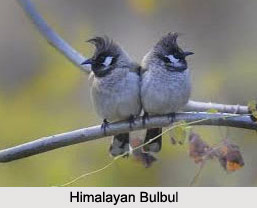 Himalayan Bulbul is an Indian bird that bears a scientific name "Pycnonotus leucogenys" concentrated in the Himalayan Mountain Range mostly in the Middle Himalayan Range and Shiwalik Mountain Range.
Himalayan Bulbul is an Indian bird that bears a scientific name "Pycnonotus leucogenys" concentrated in the Himalayan Mountain Range mostly in the Middle Himalayan Range and Shiwalik Mountain Range.
Category of Himalayan Bulbul
Himalayan Bulbul or White-Cheeked Bulbul is a species of songbird in the Pycnonotidae family.
Behaviour of Himalayan Bulbul
While Himalayan Bulbuls are mixed with humans from a young age, they will become friendly to humans.
Concentration of Himalayan Bulbul
Himalayan Bulbul is found in the northern regions of the Indian subcontinent as well as some adjoining areas. It is found in Afghanistan, Bhutan, India, Nepal, Pakistan and Tajikistan.
Structure of Himalayan Bulbul
Himalayan Bulbul length is about 18 cm, wingspan of 25.5 to 28 cm and the weight of an average is about 30 g. Bird`s head, throat, and crest are black and white. The back side, and a lengthy tail are brown, the underside are pale yellow. Both sexes have the same colour. The song is a beautiful 4-piece whistle, which resembles an accelerated oriole whistle
Habitat of Himalayan Bulbul
Himalayan Bulbul habitats are found in the dry alpine forests, and in the rich shrub layer. Himalayan Bulbuls also appear gardens and roadsides. Sometimes Himalayan Bulbuls are found in the gardens and parks where human visitors would leave food. This invites flies and other insects that are its main food.
Nests of Himalayan Bulbul
Himalayan Bulbul is often seen preparing a small cup-shaped nest, made of herbs, roots and twigs. The nest is usually built in the bush or low tree branch. The female lays usually three eggs, which are incubated for 12 days. The chicks leave the nest that is 9 to 11 days old. Flips are evaluated as two or three during the summer. During the breeding season this bird is very combative towards other birds.
Feeding of Himalayan Bulbul
Himalayan Bulbul eats insects and other small invertebrates and berries, fruits, seeds, buds and nectar.



















